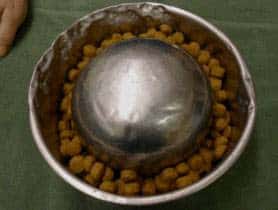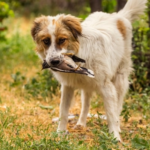
What causes the gas?
Flatulence comes from an excess of gases in the intestinal tract. These gases may represent air that has been swallowed, gas produced in the biochemical process of digestion, gas diffusion from the bloodstream, or gases produced by the bacteria that populate the intestinal tract. Over 99% of the gases that pass from the intestinal tract are odorless; the gases with objectionable odors are typically those containing hydrogen sulfide.
Flatulence is a normal biological function. A surprising amount of air is swallowed with the simple act of eating and if this is not burped out, it must exit through the other end. The amount of air swallowed tends to be increased when dogs feel they must eat quickly or in the brachycephalic breeds who tend to breathe more by mouth rather than by nose. Swallowed air tends not to have objectionable odor.
The smelly gases are produced by colon (large intestine) bacteria. Dietary fiber in pet food is not readily digestible by the pet’s own enzyme systems but is readily digested by the gas-producing bacteria of the colon. As these fibers are broken down, gases are produced. A diet heavy in fibers tends to favor gas-producing organisms. The more supportive the intestinal environment, the more bacteria there will be and more gas will result.
What to do

The following are easy changes that can be made in your management of the pet:
- An upside down bowl in a larger bowl slows down feeding and makes your dog eat slowerFeed smaller meals several times daily instead of one larger daily meal.
- Feed a mixture of dry and canned foods.
- Discourage rapid eating by placing an over-turned small bowl inside the pet’s regular food bowl. This prevents the pet from taking such a large mouthful.
- Avoid soy and peas in the diet.
- Avoid any treats containing milk, cheese or other forms of lactose.
- Avoid fresh or dried fruit treats.
- Change to a high digestibility/low residue diet (that means less fiber). Your veterinarian can help you select one. Ideally, rice would be the diet’s carbohydrate source.
- Avoid canned foods containing the texturing ingredient carrageenan.
- Encourage regular exercise as this keeps intestinal gases moving and prevents intestinal gasses from pooling/building up.
Changing to a low residue diet means that most of the nutrients of the food are digested and absorbed by the pet before they reach the colon where the gas-forming bacteria are. This means there will be less food for the gas-forming organisms, which will ultimately mean fewer gas-forming organisms and less gas formed.
Sometimes just going through a case and/or bag of a low residue diet solves the problem and the pet can return to a regular food afterwards. But not always. If needed, the therapeutic (low fiber) diet can become the pet’s regular food. Low-residue diets are available through your veterinarian.
Sometimes Medication is Needed
A carminative is a medication that reduces flatulence. There is an assortment of available products, but unfortunately most are not helpful or even labeled for animal use. Changing the diet and ruling out actual intestinal disease are of primary importance in addressing flatulence. If further therapy is needed, the following products have some basis to suspect they might work:
Yucca shidigera supplementation
Currently this extract is labeled as a flavoring agent for pet food but it is also available as an oral supplement. Several studies have shown that it helps decrease the odor in flatulence.
Zinc acetate supplementation
Zinc binds to sulfhydryl compounds in flatulence ultimately serving to deodorize the gas.
Non-absorbable antibiotics
Such antibiotics serve to kill the gas-forming bacteria of the colon and may be helpful as long as their use is not ongoing.
Probiotics have some potential
Probiotics
There are many ineffective probiotics being marketed so it is important to use one that has been shown to actually contain live cultures and that its cultures withstand stomach digestion so as to populate the small intestine with beneficial bacteria. There are several veterinary products that are felt to be reputable: Prostora® Proviable® and Fortiflora®. Fortiflora, Purina’s product, has been shown to be effective in reducing flatulence. Visbiome is a newer probiotic proven to have the appropriate bacteria to help the canine intestinal tract.


